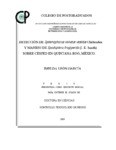Detección de Sphenophorua venatus vestitus Chittenden y manejo de Spodoptera frugiperda (L.E. Smith) sobre césped de Quintana Roo, México
Abstract
Debido a la importancia económica, social y ambiental de los campos de golf en
México, y a la falta de información para iniciar programas de manejo integrado de plagas en
césped de estos, en este trabajo se planteó realizar un diagnóstico de especies plaga de
importancia en campos de la Riviera Maya y determinar su fluctuación poblacional, evaluar
los niveles de resistencia de Spodoptera frugiperda a insecticidas de uso común en la zona de
estudio, y determinar los efectos letales de un insecticida con novedoso modo de acción
(Rynaxypyr®) sobre estados inmaduros de esta plaga. Se realizaron muestreos directos al
césped y se procedió a la identificación de los insectos problema. Se registró por primera vez
en Quintana Roo Shenophorus venatus vestitus (Chittenden), subespecie con restricciones
cuarentenarias en nuestro país, y se describió e ilustró su genitalia. Por otro lado, Spodoptera
frugiperda fue la única especie plaga de lepidópteros en la zona y daña al césped de los
campos de la Riviera Maya. De marzo de 2007 a marzo de 2008 se realizó monitoreo de S.
frugiperda con feromona sexual sintética en el campo de golf Iberostar Playa Paraíso. Los
machos de S. frugiperda estuvieron presentes todo el año con una media de 10 insectos por
trampa, pero se detectaron dos picos poblacionales, uno en junio y otro en septiembre con
promedios de 20 y 45 insectos por trampa, respectivamente. Como esta especie fue la más recurrente en el césped, y tiene historial en el desarrollo de resistencia a insecticidas, se
realizaron bioensayos por aplicación tópica para conocer sus niveles de resistencia a
insecticidas de uso común en la zona de estudio. La población de campo, comparada con una
población susceptible, tuvo diferentes niveles de resistencia a todos los productos. Para la
mortalidad al 50% la proporción de resistencia (RR50) se presentó en el siguiente orden,
deltamethrina 1002.2×, lambdacialotrina 204.5×, metomilo 183.0× y ciflutrina 162.7×. Para la
mortalidad al 95%, la proporción de resistencia (RR95) fue de 207.8, 290.2, 29.7 y 564.6×,
respectivamente. Con respecto a efectos de Rynaxypyr® sobre S. frugiperda, se encontró que
este insecticida no presentó actividad ovicida, pero las larvas alimentadas con dieta tratada
presentaron una CL50 de 0.00001 µg/larva, y una CL95 de 0.0155 µg/larva. En aplicación
tópica se encontró una DL50 y DL95 de 0.0008 y 0.2874 µg/larva, respectivamente. Se discute
la importancia de estos hallazgos para iniciar programas de manejo integrado en campos de
golf en México.______Because of the economic, social and enviromental importance of golf courses in
Mexico, and because of the lack of informacion to support integrated pest management on
turfgrass of these fields, the objectives of this work were a) to know the golf courses pests and
its population fluctuation at the Riviera Maya, Quintana Roo, b) to determine resistence leves
of Spodoptera frugiperda to common insecticides that people used at that zone, and c) to
determine the lethal effects of a novel action mode insecticide (Rynaxypyr®) on the immature
stages of S. frugiperda. We sampled directly on the turfgrass golfcourses and identified the
insect problem. We detected Shenophorus venatus vestitus (Chittenden) for the first time at
Quintana Roo, and we described and illustrated its genitalia. This insect has quarantine
importance in our country. On the other hand, Spodoptera frugiperda was the only
Lepidoptera pests in that place and causes damage on the turfgrass on golfcourses at the
Riviera Maya. From Marh 2007 to March 2008 the S. frugiperda populations was monitored
using sexual pheromone traps at the Iberostar Playa Paraiso golfcourse. Males of S. frugiperda
were present all along the year with an average of 10 insects per trap. However, two
population increments were detected, one in June with 20 insects per trap and another during
September with 45 insects per trap. As this species was recurrent on turfgrass and it has some resistence history on other crops, some topical applications were developed in order to
determine the resistence levels for insecticides used at that place. We found that the field
population, compared to a susceptible, presented different levesl of resistence to any product.
For DL50, the proportion of resistance (RR50) was deltamethrin 1002.2×, lambda-cihalothrin
204.5×, methomyl 183.0× and cifluthrin 162.7×. For DL95, the proportion of resistance (RR95)
was of 207.8, 290.2, 29.7 and 564.6×, respectively. About the Rynaxypyr® effects on S.
frugiperda, the insecticide did not show ovicide effect on the evaluated dilutions, but larvae
were susceptible to both application methods. For diet with insecticide we got CL50 of
0.00001 µg/larva, and CL95 of 0.0155 µg/larva. About the topical application the DL50 was
0.0008 µg/larva, and DL95 was 0.2874 µg/larva. The importance of this research and the
possibilities of supporting integrated pest management at golf courses in Mexico are
discussed.
Collections
- Tesis MC, MT, MP y DC [284]


